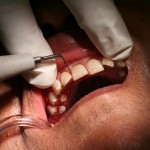
Following a course of active periodontal treatment some patients require ongoing periodontal maintenance/supportive periodontal therapy. The use of manual or ultrasonic instruments may cause damage to the root surface. A potential alternative is air polishing devices that have been shown to remove bacterial deposits during supportive periodontal therapy.
The aim of this review was to compare the outcomes of air polishing devices with conventional periodontal therapy (hand instrumentation and/or ultrasonic debridement), in patients undergoing periodontal maintenance therapy.
Methods
A review protocol was registered with PROSPERO. Searches were conducting in the Medline/PubMed, Embase, Cochrane Library, Web of Science and Clinical Trials.org databases. Randomised controlled trials (RCTs) comparing the use of an air- polishing device to hand instruments and/or ultrasonic devices during periodontal maintenance/supportive periodontal therapy (PMT//SPT) published in English, Spanish or Portuguese were considered. The primary outcomes were bleeding on probing (BoP), gingival indices (GIO and/or bleeding index (BI), with probing depth (PD), clinical attachment level (CAL), plaque index (PI), microbiological counts and/or patient tolerance as secondary outcomes. Two reviewers independently screened studies extracted data and assessed risk of bias using the Cochrane domains-based tool. A narrative summary was presented.
Results
- 14 studies (3 parallel, 11 split mouth) were included.
- Sample sizes ranged from 10 to 50 with follow up times varying from 1 week to 1 year.
- All 14 studies were considered to be at high risk of bias.
Bleeding on probing (9 studies)
- Glycine was used in 4 studies, erythritol in 4 studies and trehalose powder in one study with all studies reporting no statistically significant BoP differences
Gingival index (2 studies)
- One study reported no differences between group with the other reporting a statistically significant difference in favour of ultrasound cleaning.
Bleeding Index (1 study)
- This study reported that marginal gingival bleeding scores decreased in both air-polishing and ultrasonic scaling groups.
Probing depth (9 studies)
- Glycine was used in 4 studies, erythritol in 4 studies and trehalose powder in one study. Except for 1 study that reported air polishing with glycine powder displayed a statistically significant higher PD compared to hand instruments no differences were reported between the groups.
Clinical attachment level (6 studies)
- 3 studies used erythritol, 2 glycine and 1 trehalose powder. 4 studies reported no statistically significant differences between the groups. Two studies reported statistically significant differences in favour of the control groups.
Plaque index (7 studies)
3 studies used erythritol, 2 glycine, 1 trehalose powder and one glycine and sodium bicarbonate powders. No statistically significant differences were seen in 5 of the 7 studies.
Bacterial counts (11 studies)
- 7 studies used glycine 3 used erythritol and 1 trehalose powder. Six of the 11 studies reported no statistically significant differences. 3 reported the test group having a higher bacterial count and one study a lower level of Aggregatibacter actinomycetemcomitans than controls.
Patient comfort (8 studies)
- 4 studies used glycine 3 used erythritol and 1 trehalose powder.7 studies reported a statistically significant benefit for patient benefit in favour of air polishing with one study reporting no difference.
Conclusions
The authors concluded: –
…both air polishing devices and other conventional techniques show comparable clinical efficacy, however, air polishing devices show potentially better microbiological behaviour and are also a safe, faster and more comfortable option for patients undergoing SPT.
Comments
The reviewers pre-registered a protocol and searched a good range of databases including publications in English, Spanish or Portuguese so publication in other languages may have been excluded.14 studies were included with a majority being of a split mouth design with two of these employing a quadrant design. While the split mouth design offers some potential benefits there is the potential for cross-over effects so parallel designs may be better for future studies. All the included studies were considered to be at high risk of bias because of a lack of blinding of study participants and personnel, a majority of the studies also had concerns regarding the randomisation procedures and allocation concealment. In addition, the studies are small and with variable follow-up periods and polishing agents. Although the findings suggest that air polishing devices show comparable efficacy to traditional approaches the available evidence isof low certainty so additional high quality and well reported studies employing common outcome sets are needed to provide better quality evidence.
Links
Primary Paper
Martins O, Costa A, Silva D. The efficacy of air polishing devices in supportive periodontal therapy: Clinical, microbiological and patient-centred outcomes. A systematic review. Int J Dent Hyg. 2022 Oct 27. doi: 10.1111/idh.12635. Epub ahead of print. PMID: 36300683.
Other references
Dental Elf – Mar 30th 2022
Air polishing or hand and/or power-driven instruments in supportive periodontal therapy
eryth
